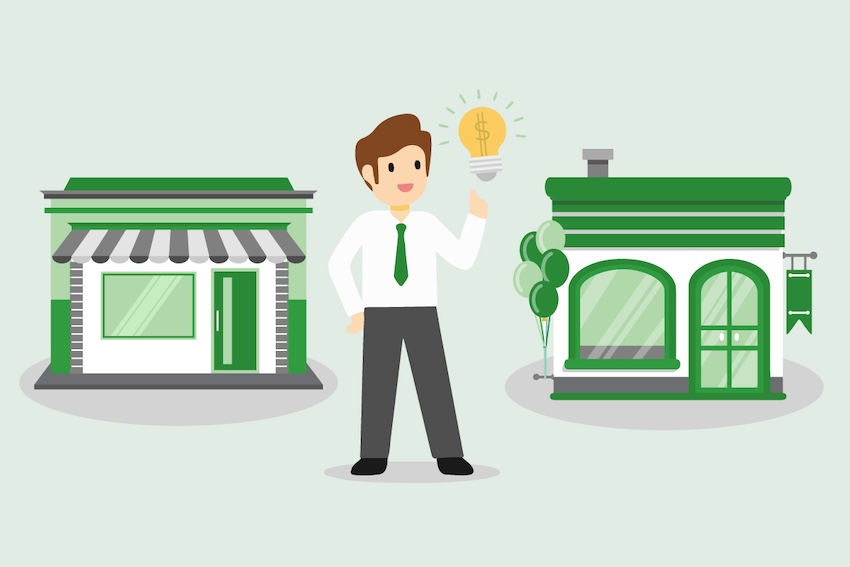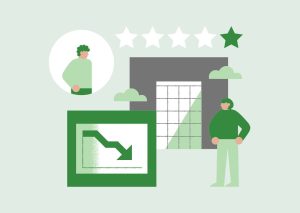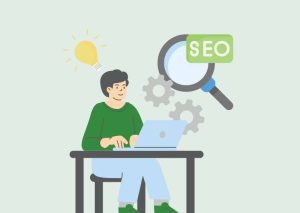
How to Win Big B2B Clients
In this third episode of The BizWisdom show, Sam talks about B2B marketing and businesses. If you’ve ever worked in a B2B business and asked the question, “How do I win the big clients?” or “How do we get more of the big clients?” then this is the episode for you!
How do you go about winning big B2B clients?
In B2B, we all want the big clients. But the bigger the fish, the more effort you need to reel them in. Knowing this, here’s what I believe (and always believed) is the best strategy for B2B brands to target and win big clients.
Take Advantage of the 95/5 Rule
Jenny Romaniuk’s How Brands Grow Too, a concise yet powerful follow-up to Byron Sharp’s How Brands Grow, introduces the 95/5 Rule concept. This rule highlights this key insight:
Your target audience actively seeks your product or service only about 5% of the time. The remaining 95%, they are not actively searching, considering switching providers, or immediately interested.
But this doesn’t mean they are out of reach; they are simply not in the “market” at that moment. B2B customers potentially renew service providers every five years. That means your window of opportunity is specific:
You have five years to penetrate your customer’s consciousness, influence the customer, set yourself in the customer’s mind, and position yourself as the leader in your area of specialisation.
When they are ready, your target audience becomes actively interested in your product category. During these times, they are highly engaged researchers and potential buyers.
So, while you need to work on them for a long period of time, the good news is you’ve got time to let your messaging wash over your customer and then set up a campaign that looks for these category entry points. During this time, you can create systems so that when your target audience is in the market, they can put their hand up and make themselves known to you.
Remember that they might not be ready today, but with sustained effort, you can significantly influence their decision-making process when the time comes.
Understand Account-Based Marketing (ABM)
The next principle you need to understand is account-based marketing (ABM). The idea of ABM is in its focus. It’s like regular marketing, but you focus on winning a single account.
For example, you decide to win Coca-Cola.
That might be very difficult, so you spend time strategising and identifying the key contacts you need to influence within Coca-Cola.
Then you start building out marketing collateral and a whole marketing campaign–just like you would for mass marketing–but take this campaign straight to those key contacts instead. You use various tactics to influence them and make sure that wherever those people are, they see your brand.
This approach is most effective when combined with direct sales outreach. In this scenario, the marketing and sales teams work synergistically: the sales team identifies critical contacts and potential customers, while the marketing team supports the salesperson in reaching those key stakeholders and building this marketing around them.
While our agency can’t manage pure one-account or one-campaign projects, we recommend identifying your dream 100 or even 1,000 clients and building targeted ABM campaigns around them.
Then you incorporate the 95-5 rule, which means your ABM strategy will focus on influencing the right individuals at the crucial category entry points when they’re most receptive to your message. This combined approach significantly increases your chances of winning over your ideal clients when they’re actively seeking solutions in your industry.
At BizWisdom, we build what we call a pre-targeting program. We start with lists of key contacts from within those key prospects we plan to target (or key dream clients, as we like to call them), and we build a brand awareness campaign to make sure that every one of those targets comes into contact with your brand in one way.
While the program might not generate immediate widespread awareness, it lays the groundwork for future lead generation. The goal is to establish a baseline familiarity with your brand through a series of touchpoints. This sets the stage for future lead nurturing efforts and increases the likelihood of these key contacts recognising your brand when they enter the “market” for your offerings.
Start Cold Outreach
One step to increasing your brand awareness is through cold outreach. There are three ways to do that:
- Cold email
- Cold LinkedIn outreach
- Cold calling
The sales team will have to put some legwork in here. Typically, I reach out via LinkedIn to connect or view the profile. People get those little notifications that somebody’s viewed their profile, and they go, “Oh, yeah, I recognise this name.” There are tools that can do this for you and automate this to some degree. Make use of them.
Then, follow up with some direct email outreach. You’ll probably want to have a four- or five-part email sequence. There’s some great literature on what to include in those, and there are also great scripts you can use.
Other great tactics you can try are:
- Recording a Loom video. There’s a trend going around when people record a video with the prospect’s website behind their heads. It shows, “Hey, I’m a real person, and I’m here to talk to you. This isn’t some bulk outreach thing that I’m doing.”
- Writing names on coffee cups and saying, “Hey, I’d love a coffee with you,” and put their name on the coffee cup.
Cold outreach might seem gimmicky, but it can be surprisingly successful. We’ve all been on the receiving end and thought, ‘This is terrible, who would respond to this?’ But the truth is, many people do.
The key lies in personalisation. The more you can demonstrate you’re a real person reaching out, not a faceless entity sending mass emails, the better. Show you understand their business and their location – anything that proves this outreach isn’t a generic spray-and-pray tactic. This personalised approach goes a long way in capturing attention.
Then I propose you follow up with a phone call. A simple “Hi, I reached out on LinkedIn and followed up with an email. Just wanted to see if you’d be open to a brief chat” can be surprisingly effective.
Retarget with an Ad
After introducing your brand offering through pre-targeting tactics like downloadable resources, shift to retargeting. Strategically place ads across various platforms like Facebook, LinkedIn, display networks, and even podcasts to stay visible to potential customers who may have initially ignored your outreach.
Retargeting ensures they see your brand name and message again, perhaps through a video or customer testimonial. This subconscious connection can lead them to engage with your future outreach attempts or simply register your brand in their mind for future reference.
Even if prospects aren’t ready to buy now (the 95-5 rule), they’ll become familiar with your brand. This way, they’ll likely remember you and consider your services when they enter the market.
This happened to me, but exactly the other way around, with a graphic design services brand.
I saw an ad about them but wasn’t interested in their services for two or three years. Then we lost our graphic designer. We were in a real pickle. We couldn’t hire someone fast enough to deliver the work we needed, and we had a long list of outstanding tasks. Then I remembered their name. I thought, “Oh, thank you. Very entry point!”
I’m now in the market for this. I know they can provide it. I’ve seen all their content. I know they can provide a stopgap solution to help us get through this period until we hire another graphic designer. So bang, “Sign me up!”
It turned out their service was incredible, and we’ve been their customers for the long run.
So that’s what the 95-5 rule is about. All of this will work together to hopefully win the customer, but if not, at least solidify your name in their mind.
Track and Analyse
After cold outreach and retargeting, tie everything together with excellent tracking and analysis. The Customer Relationship Management (CRM) tool we use for this is HubSpot. There are other options, but we use HubSpot because of its capabilities.
HubSpot allows us to track all these leads and see the ones that are engaging, the ones that have activity on the website, and the ones that are considering. From this information, we can build reports for your sales team to help them uncover which ones are actually in the market and which ones are hot and then follow up. This is particularly important if you’re going after thousands of leads rather than 100 or 50, or 1.
Map Your Messaging
The buyer journey is often visualised as a funnel with three key stages: awareness, consideration, and decision.
The prospect’s needs and receptiveness to different messages change at each stage. The further up the funnel they go, the colder they are. The colder they are, the less likely they are to commit to big-budget advertising.
Some say, “Oh yeah, I’m going to spend tens of thousands or hundreds of thousands of dollars on your amazing B2B solution.” If they’ve never heard of you, that’s a big jump.
Instead, make sure that the right communication pieces are being presented to that prospect at the right time.
Top of the funnel (Awareness)
This stage focuses on building brand awareness and educating prospects about their needs. You’re saying, “This is who we are, this is why we’re great…this is our brand name.”
You’re getting them to see your colours, your logo, and maybe some of your key value propositions. Examples include white papers or industry data, where you talk about how businesses like yours solve problems in the industry.
Not everyone will be interested in your offer, but that allows you to find the right audience. As long as your audience is interested, then it’s serving its purpose because it helps to identify great prospects.
Middle of the funnel (Consideration)
By this stage, prospects should know who you are now. They’ve received a couple of your emails, had a couple of touchpoints with you, or should be familiar with your brand name, at least.
This is where you start to show why you’re good—showcase case studies of businesses like theirs that have used you and had great experiences. Testimonials and webinars can also be good here.
Bottom of the funnel (Decision)
This stage involves converting leads into customers. Messaging becomes more direct and action-oriented, using clear calls to action like “Book a discovery call” or “Speak to us today.” The sales team plays a crucial role in engaging with qualified leads and closing deals.
Remember the Flywheel Effect
To explain how winning big B2B clients is challenging, let me use the flywheel analogy. You cannot simply say, “Let’s jump in for two months and win big clients.” That’s unrealistic.
Instead, the flywheel effect concept suggests getting new customers takes a lot of work. You might try advertising, promotions, or even cold calling. It can also feel slow and frustrating. But once you start attracting customers and they have a good experience, they might tell their friends or return for more.
Large clients require significant effort to win over. They face constant pitches due to their desirability. They encounter numerous businesses like yours, all vying for their attention.
Your product needs exceptional quality to stand out. You must also be willing to invest time or establish yourself as the leader in their minds. Otherwise, your chances are slim.
Remember, they have their pick of any vendor. Often, they have substantial budgets, allowing them to work only with the “best of the best.” Therefore, you require a unique offering and dedicated time to solidify your position as their preferred choice.
This is where maximising those four or five years–when your target prospect isn’t actively seeking your product–becomes vital. Use this time to showcase your value proposition and establish your position as a frontrunner.
But even after acquiring them, the work continues. They will still attract constant pitches from your competitors. Depending on your industry, there’s likely a whole other discussion about continuously delivering exceptional value and introducing new ideas because your competitors will be doing the same.
Focus on Achievable Targets
In summary, when starting a business, focus on small, achievable targets, secure a win, and then build upon that. Don’t try to replicate sophisticated businesses with complex marketing programs right away. Start simple, test, confirm, iterate, and then build upon that one win at a time. This approach helps ensure your startup survives and thrives.
Follow The BizWisdom Show for More Business Insights
Enjoying The BizWisdom Show so far? Catch the streams as they go live by following us on YouTube or following Sam on LinkedIn. You can also subscribe below:
If you want to catch more of Sam, check out the Brandwith® Podcast with co-host Dean Millson, available on:
Looking to launch your business with inspired digital advertising? Contact Sam today to find out all the ways that BizWisdom can help with lead generation, increased sales, improved brand awareness, and more!


